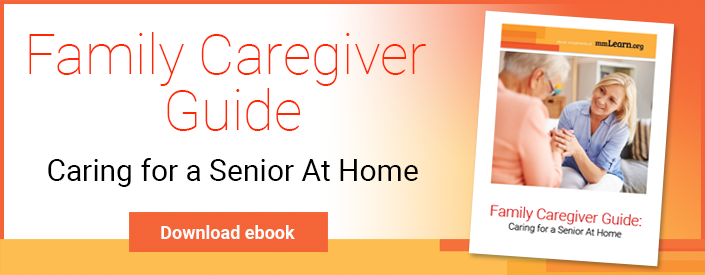 Every single older person is different, and each has different care needs.
Every single older person is different, and each has different care needs.
Even though nursing homes, assisted living, and skilled nursing facilities are providing excellent care for some older people, they aren’t the right place for everyone.
What about in-home care, or aging in place?
The Benefits of In-Home Care
The options continue to open up for older people who want to age in place. But in most cases, staying at home when you are older requires planning and support.
In-home care is one increasingly popular form of care that is meeting the needs of some older people and their caregivers. From meal preparation and housekeeping duties to personal care and transportation services, in-home caregivers provide a multitude of critical services to aging loved ones and the people who care for them.
In-home care supplements the work of family caregivers, who often spend many hours a week on caregiving tasks. When professionals come in for a few hours every day or week, caregivers can focus on self-care and avoid burnout.
Bridging the Distance
What about people who don’t live near their aging relatives?
According to the AARP, 40 percent of people over the age of 50 have children living at least five hours' driving distance from them. This distance makes it challenging to help coordinate and care for aging loved ones. In-home care can provide peace of mind for family members in this situation. It is reassuring to know that a loved one is being cared for when you can’t be there. And it also makes life easier for caregivers who do live nearby.
Easing the Burden
Most family caregivers are juggling busy work and home schedules of their own while also trying to help out their aging loved one. Their personal schedules and priorities get pushed aside, which can lead to resentment and burnout. In-home caregivers can help prevent this problem, either with regularly scheduled visits or with restorative respite care.
Responding to Changing Needs
As people age, their needs change. Dementia, in particular, does not progress in a linear fashion. In-home caregivers provide flexible services and can adapt and add in services if a loved one needs more care.
It’s another way of ensuring that family caregivers don’t get overwhelmed when the needs surpass their abilities. Neither advancing age nor illness is static. As the needs of care recipients change, so do the demands on caregivers. In-home caregivers are flexible in terms of the types of services they provide, meaning that family caregivers aren't overwhelmed by a continually growing list of responsibilities.
Adapting a Home to Aging in Place
Most homes aren’t set up for people to grow old. But many of them can be adapted to help people age in place. Family caregivers need to take a close look at the space and learn about potential hazards and adaptive features to make life easier for the older person and anyone assisting with caregiving.
Fall Prevention
Falling can be extremely dangerous for seniors, and one in four older adults reports falling each year. But many falls can be prevented with some home safety planning.
The Centers for Disease Control and Prevention recommends doing the following four things to prevent falls.
- Talk to caregivers, health care providers, doctors, and pharmacists about fall prevention.
- Keep moving. Strong legs and good balance can help prevent falls. There are plenty of fall prevention classes out there, including some creative approaches like yoga and dance classes.
- Get an annual eye exam, and keep eyeglass prescriptions up to date.
- Make your home fall safe. In general, that means removing objects and clutter that get in the way of safe passage. It can also mean investing in some modifications to make spaces safer for people whose cognitive and physical abilities are changing.
Making a “Fall Safe” Home
This mmLearn video shows a few simple things such as ramps, grab bars, and walk-in showers that can be added or adapted to prevent falls. The other family caregiver videos show how to handle entryways, living areas, and bedrooms and bathrooms.
Safe at Home
Entryways
Living Areas
Bedrooms and Bathrooms
What About Medicare and Aging in Place?
Depending on the circumstances, Medicare may help cover services that involve skilled nursing, social work, or physical, occupational, or speech therapies. There are some general guidelines that apply, though, so it’s always good to consult with someone like an elder law attorney who can help you navigate these care rules.
What are some of the rules?
- A Medicare doctor must prescribe the care during a face-to-face appointment.
- The person needing care must be homebound, meaning they require special durable medical equipment, like a cane or walker, to leave the home.
- Medicare often doesn’t cover care if someone only needs custodial care like feeding or assistance with bathing.
Although Medicare does cover a number of home health care services, including skilled nursing, it does not pay for all the care. Both Medicare Part A and Part B have deductibles, coinsurance, and copays that the patient is responsible for.
For home health care that falls under Medicare Part B, Medicare will pay for 80% of the cost of care after the patient meets the small annual Part B deductible. Some Medicare beneficiaries are enrolled in Medicare supplemental coverage that may help to cover some or all of this cost-sharing.
And Medicare does not cover long-term care in a nursing home or assisted living facility. It will pay for the medical care received while living in such a facility, but it does not pay for the facility itself. For people with low income and few assets, Medicaid does provide financial assistance for long-term care.
You should plan ahead to pay for this on your own or via a long-term care insurance policy that you established when you were still healthy. If you are unable to pay for his care, you might qualify for financial assistance from Medicaid, which is a health care program for people with low incomes and assets.
Home Sweet Home
When family caregivers and health care providers work together to adapt homes and ensure that our loved ones get the professional care they need to address their changing conditions, aging in place becomes a viable, and comforting, option for many people.

